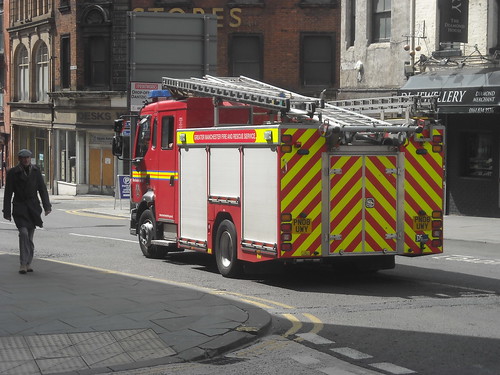Millions spent on PFI “white elephants” as fire service staff face sack
Article published: Tuesday, April 17th 2012
Hundreds of local frontline fire service staff face the sack despite millions of pounds of public money used to bailout a national initiative undertaken by the previous government and denounced by Parliamentary watchdogs as “one of the worst cases of project failure” they have seen “in many years”.

Photograph: Gene Hunt
Greater Manchester’s Fire Service is under severe pressure following an unprecedented budget cut of £23m over the next four years and the potential loss of 282 jobs. While no stations are planned to close under current proposals, subject to consultation, some will see their resources diminish if they are perceived to be in ‘low risk’ areas such as Cheadle or Altrincham.
Despite the £23m hole in the Fire Authority’s budget, the Department for Communities and Local Government (CLG) pays £142,000 each month to rent an empty fire control centre in Lingley Mere, Warrington. A legacy of a failed project to consolidate England’s 46 existing fire control centres for co-ordinating emergency responses into nine regional locations, the national ‘FiReControl’ scheme was finally scrapped in 2010 after repeated failures wasted almost £500m. It left the fire service with what the Public Accounts Committee chair Margaret Hodge MP scathingly called nine “white elephants”.
Embarked upon by the Labour government in 2003 and originally forecast to cost £120m, costs spiraled due to what the committee deemed a failure to apply “basic approval checks and balances” such as business plans which had been developed and tested among fire services. The committee also highlighted the poor oversight of the controversial European weapons company EADS, since renamed Cassidian, which was contracted to deliver vital communication systems, as well as an enormous £69m spent on consultants. Most of the control centres still have not been used, and a further £84.8m will now be spent to bailout stalled schemes across the country.
Spiralling costs
One member of the committee, Matthew Hancock MP, calculated that the amount of money spent on “over engineering” these centres so that the controllers around the country could speak to one another came to £400,000 per controller. The expense prompted him to ask Sir Bob Kerslake, Permanent Secretary at CLG, and now Head of the Home Civil Service as well, “Would it not have been better to buy them all mobile phones?” Shocked by the scandal, Manchester Fire Brigade Union (FBU) Branch Secretary Paul Fogerty told MULE that “the £500m pounds spent on this project would be enough to offset the whole UK deficit that all brigades are currently facing.”
So far central government has shelled out for the total cost of the empty centres, but the days of 100 per cent government subsidy for the lease and running costs of Lingley Mere are numbered. When the centre finally becomes operational in 2014 the North West fire authorities of Greater Manchester, Lancashire, Cheshire and Cumbria will become jointly responsible for 33 per cent of the lease cost and all of the running costs.
North West Fire Control Limited (NWFC Ltd), the company responsible for running the centre, argues sharing the costs of capital investment between the five authorities and reducing staff levels by a third will yield significant savings overall. FBU North West regional secretary Kevin Brown disagreed with the perceived benefits however, criticising the job losses and the loss of local knowledge as well as reliance on “untried and untested” IT communication software in the merged centre which will cover most of the North West.
Questionable expense
Brown also disputed the view that the merger would lead to savings, telling MULE, “The government are giving us two thirds of the rent towards a building that we don’t need, Manchester already owns the building for the existing control centre. I don’t understand how this can lead to a saving but apparently there is a saving somewhere on a balance sheet.”
MULE can reveal that the chairman of the board of directors of NWFC Ltd is Councillor Fred Walker, who stepped down last summer as chairman of the Fire Authority after sparking fury over expenses claims. When questioned on whether they thought Walker was an appropriate choice, a Fire Authority spokesperson said, “Cllr Fred Walker was voted onto the board by the current Fire Authority, who thought it appropriate because of his experience and knowledge of the project.”
Not everyone has lost out. AAIM Warrington Unit Trust are the legal owners of Lingley Mere, who are themselves owned by the Jersey-based AAIM Property Fund 1 Limited, part of the wider AAIM Group plc. AAIM’s Channel Island registration leaves it subject to 0 per cent corporation tax according to its report of financial statements and the property fund enjoys the backing of a wide range of individual and institutional investors including X-Factor judge Simon Cowell.
Unaccountable
As yet, no-one has lost their job over the scandal. Many project managers have now retired while others have moved on to new projects or civil service positions. According to Hodge, the CLG Accounting Officer between 2005 and 2010 is now the top civil servant in Scotland. When grilled by the committee as to why a project of this scale was undertaken with such urgency, and without proper planning, Kerslake revealed that there was a fixation on national resilience “born out of issues that were raised under the experience of 9/11 and indeed some of the natural disasters around flooding.”
Fogerty, however, is concerned over the resilience of the control centres today. He is worried that if anything goes wrong with the facility they will have more difficulty keeping operations going. “Due to the undeliverable IT solution, the centres cannot communicate with each other, but instead stand alone, more vulnerable than ever,” he explained.
Indeed Greater Manchester’s own Fire Authority appears to have little choice. Consistent throughout the project has been lack of consultation with local fire authorities and trade unions to get their opinion on the benefits and drawbacks of the plans or to offer them a chance to negotiate the terms of the contract on the building. It was widely known by those involved with the project that they did not have “buy-in” from individual fire services from the start.
When questioned about the plan to move into the regional control centre, a spokesperson for the Fire Authority said, “We don’t have a choice in doing it and making the project work – it is going to have to be a success.”
The ‘government knows best’ attitude was summed up by FBU Parliamentary Group chair Kate Hoey MP, who explained to MULE that “The politicians and senior civil servants responsible for this debacle stroll off into the sunset leaving the taxpayer and the emergency services to carry the can.”
Sam Cordon
Comments
-
[…] Millions spent on PFI “white elephants” as fire service staff face sack … […]
Pingback by NSW Govt may scrap IT shared services units - The Society – Entrepreneurs Epicentre on April 17, 2012 at 9:10 pm -
パーカー ナイロン
Comment by ロレックス 中古 on September 10, 2013 at 4:00 am
The comments are closed.



